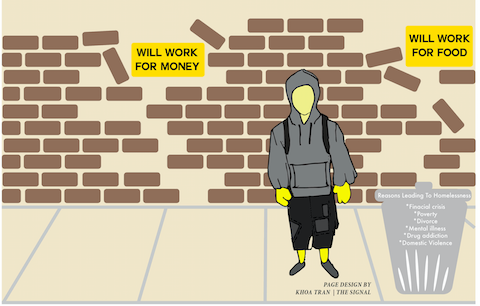
Homelessness is clearly a problem on and around Georgia State campus. It has nothing to do, particularly, with Georgia State itself, but it’s refreshing to see the university doing more than it’s required to do to help alleviate the problem.
Why people become homeless
There are many reasons people become homeless. PovertyLiving.com names the major factors as: poverty, financial crisis, divorce, mental illness, drug addiction, and domestic violence.
An article written by The Signal on September, 2015 makes a distinction between adult homeless and youth homeless, a distinction which is echoed in many other resources. One difference between older homeless and youth homeless is the reasons they became homeless in the first place.
“While sexual orientation and gender identity are common reasons youths find themselves without a home, there are many others,” according to an article by WABE. “ Georgia State volunteers conducting the survey say they often hear how the death of a parent, the need to escape an abusive situation, and drug and alcohol addiction force them to the streets.”
“Every one third of the US population are children and youth,” according to GSU News.
In the aforementioned Signal article, the distinction is further drawn between older homeless and youth homeless along the lines of geography:
“Actually a lot of the research shows that if there is older, chronic homelessness, generally homeless youth will not be in the same areas, because they’re more likely to be victimized by the chronically homeless,” Georgia State student Chris Vidnar was quoted as saying in the article.
It’s interesting that this distinction would be made between older and younger homeless, and that the causes of their homelessness would be different depending on what generation they belong to.
But this makes sense, considering those of us who are young might not struggle with the types of things which could make our parents homeless; there are forces which may force us out of our own homes.
So for students, it’s important to understand the pitfalls which deprive people of homes, and to avoid the ones that can be avoided–but I am by no means saying that not having a home is anyone’s fault.
According to the Coalition for the Homeless, there are “proven ways” to alleviate homelessness, presumably for both the young and old. Though they are based in and mostly refer to homeless in New York City, their methods can be applied universally.
They take a housing-first approach to combating homelessness, urging people to fight homelessness by “stabilizing people through shelter, moving them into permanent housing, and implementing assistance programs to keep them in their housing.”
It seems intuitive that giving people homes would keep them from being home-less, because considering models like Maslow’s hierarchy of needs, shelter is one of the most important things people can have.
The most important rung falls under the category of “physiological,” which includes “air, food, drink, shelter, warmth, sex, sleep, etc,” according to Simply Psychology. Yet shelter is arguably more important than food, at least provincially in the long term.
It can also assist with the other needs on the rung, like warmth and sleep. Again, it seems intuitive, but stressing the importance of shelter as a long-term solution re-frames the solution from a simple food-based charity as offered by soup kitchens and the like–not to say soup kitchens aren’t helpful, but they are short-term.
Of course, PortlandRescueMission.org is right to point out that housing-first solutions don’t work so well for addicts, since addiction itself often leads to the loss of belongings and shelter in the first place. Unless a person can deal with the root cause of their addiction, they will always be on the down slope to homelessness.
These suggestions seem a little secondary after considering the importance of the housing issue. Contrast those suggestions with what Georgia State does to combat homelessness in Atlanta, the university certainly has the “ensuring education and employment” part provided in its own way.
The Signal article I referenced earlier told the story of the Atlanta Youth Count! team, a group led by Georgia State sociology professor Eric Wright, which found the number of homeless youths in Atlanta is much higher than the Federal Government’s yearly count suggested, according to the article.
“Wright said he hopes the data will rationalize the conversation, improve community interest in shaping new policies and develop new services for homeless youth,” according to the article.
In addition to these efforts, Georgia State also hosts a Hunger and Homelessness week which offers the opportunity to raise community awareness of the struggles of the homeless in Atlanta.
There is also the Embark network, which helps homeless students with their enrollment opportunities.
Also, student organizations such as the Muslim Students Association have held events such as “Pancakes for the homeless,” which are admittedly short-term, like the soup kitchens, but show there is engagement in the fight against homelessness among the student body as well as in the faculty.
There are, I’m sure, many other things groups and individuals in Georgia State are doing to help the problem, and what I’ve mentioned are just a few of the efforts I’ve come across.
